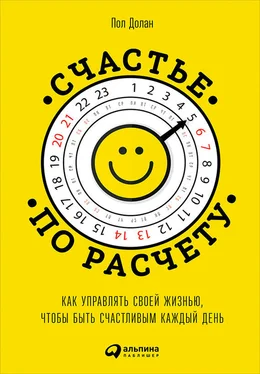Hansen T. Parenthood and happiness: a review of folk theories versus empirical evidence. Social Indicators Research 2012; 108: 29–64.
Kirchgessner M., Vlaev I., Rutledge R., Dolan P., Sharot T. Happiness in action: using measures of pleasure and purpose to predict choice. Under review, 2013.
Einstein A. Relativity: the special and general theory. Henry Holt, 1920.
O’Brien E.H., Anastasio P.A., Bushman B.J. Time crawls when you’re not having fun: feeling entitled makes dull tasks drag on. Personality and Social Psychology Bulletin 2011; 37: 1287–96; Eastwood J.D., Frischen A., Fenske M.J., Smilek D. The unengaged mind: defining boredom in terms of attention. Perspectives on Psychological Science 2012; 7: 482–95.
Harris C., Laibson D. Instantaneous gratification. Quarterly Journal of Economics 2013; 128: 205–48.
Dehaene S. The neural basis of the Weber – Fechner law: a logarithmic mental number line. Trends in Cognitive Sciences 2003; 7: 145–47.
Guven C., Senik C., Stichnoth H. You can’t be happier than your wife. Happiness gaps and divorce. Journal of Economic Behavior & Organization 2012; 82: 110–30.
Proto E., Sgroi D., Oswald A.J. Are happiness and productivity lower among young people with newly-divorced parents? An experimental and econometric approach. Experimental Economics 2012; 15: 1–23.
Hinks T., Katsoris A. Smoking ban and life satisfaction: evidence from the UK. Economic Issues 2012; 17: 23–48.
Roese N.J., Summerville A. What we regret most… and why. Personality and Social Psychology Bulletin 2005; 31: 1273–85; Zeelenberg M., Van den Bos K., Van Dijk E., Pieters R.G.M. The inaction effect in the psychology of regret. Journal of Personality and Social Psychology 2002; 82: 314–27.
Kivetz R., Keinan A. Repenting hyperopia: an analysis of self-control regrets. Journal of Consumer Research 2006; 33: 273–82.
Wittgenstein L. Philosophical investigations, 4th edition. Wiley-Blackwell, 2009.
Russell B. Autobiography. Routledge, 1998.
Scollon C.N., Kim-Prieto C., Diener E. Experience sampling: promises and pitfalls, strengths and weaknesses. Journal of Happiness Studies 2003; 4: 5–34.
Kahneman D., Krueger A.B., Schkade D.A., Schwarz N., Stone A.A. A survey method for characterizing daily life experience: the day reconstruction method. Science 2004; 306: 1776–80.
White M.P., Dolan P. Accounting for the richness of daily activities. Psychological Science 2009; 20: 1000–1008.
Csikszentmihalyi M., Hunter J. Happiness in everyday life: the uses of experience sampling. Journal of Happiness Studies 2003; 4: 185–99; Dimotakis N., Scott B.A., Koopman J. An experience sampling investigation of workplace interactions, affective states, and employee well-being. Journal of Organizational Behavior 2011; 32: 572–88.
Anxo D., Mencarini L., Pailhé A., Solaz A., Tanturri M.L., Flood L. Gender differences in time use over the life course in France, Italy, Sweden, and the US. Feminist Economics 2011; 17: 159–95.
Verbrugge L.M., Gruber-Baldini A.L., Fozard J.L. Age differences and age changes in activities: Baltimore longitudinal study of aging. Journal of Gerontology B: Psychological and Social Sciences 1996; 51B: S30–S41.
Hamermesh D.S., Lee J. Stressed out on four continents: time crunch or yuppie kvetch? Review of Economics and Statistics 2007; 89: 374–83.
Dolan P., Peasgood T., White M. Do we really know what makes us happy? A review of the economic literature on the factors associated with subjective well-being. Journal of Economic Psychology 2008; 29: 94–122.
Layard R., Mayraz G., Nickell S. The marginal utility of income. Journal of Public Economics 2008; 92: 1846–57.
Fujiwara D. Valuing the impact of adult learning. NIACE Research Paper, 2012.
Schwandt H. Unmet aspirations as an explanation for the age U-shape in human wellbeing. Centre for Economic Performance, CEP Discussion Paper No. 1229, 2013.
Deaton A., Stone A.A. Grandpa and the snapper: the wellbeing of the elderly who live with children. National Bureau of Economic Research, 2013.
Frijters P., Beatton T. The mystery of the U-shaped relationship between happiness and age. Journal of Economic Behavior & Organization 2012; 82: 525–42.
Peasgood T. Measuring wellbeing for public policy. Imperial College London, 2008; Oishi S., Diener E., Lucas R. The optimum level of well-being: can people be too happy? Perspectives on Psychological Science 2007; 2: 346–60.
Eichhorn J. Happiness for believers? Contextualizing the effects of religiosity on life-satisfaction. European Sociological Review 2012; 28: 583–93.
Schimmack U., Oishi S., Furr R.M., Funder D.C. Personality and life satisfaction: a facet-level analysis. Personality and Social Psychology Bulletin 2004; 30: 1062–75.
Sutin A., Costa Jr P., Wethington E., Eaton W. Turning points and lessons learned: stressful life events and personality trait development across middle adulthood. Psychology and Aging 2010; 25: 524–33.
Oswald A.J., Powdthavee N. Does happiness adapt? A longitudinal study of disability with implications for economists and judges. Journal of Public Economics 2008; 92: 1061–77; Lucas R.E. Adaptation and the set-point model of subjective well-being: does happiness change after major life events? Current Directions in Psychological Science 2007; 16: 75–79.
Lucas R.E., Clark A.E., Georgellis Y., Diener E. Reexamining adaptation and the set point model of happiness: reactions to changes in marital status. Journal of Personality and Social Psychology 2003; 84: 527.
Dolan P., Layard R., Metcalfe R. Measuring subjective well-being for public policy. Office for National Statistics, 2011.
First ONS annual experimental subjective well-being results. Office for National Statistics, 2012.
Stevenson B.A., Wolfers J. Paradox of declining female happiness. American Law & Economics Association Annual Meetings , Paper 107, 2008.
How’s life? Measuring well-being, OECD Publishing, 2011: http://dx.doi.org/10.1787/9789264121164-en.
Dolan P., Kavetsos G. Happy talk: mode of administration effects on subjective well-being. Centre for Economic Performance, CEP Discussion Paper No. 1159, 2012.
Deaton A., Arora R. Life at the top: the benefits of height. Economics & Human Biology 2009; 7: 133–36.
Читать дальше
Конец ознакомительного отрывка
Купить книгу












